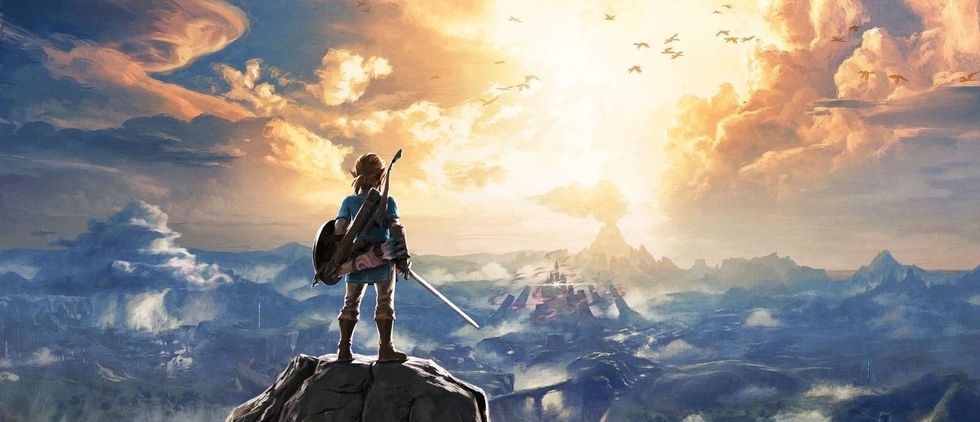The Legend of Zelda franchise has been clearing up this year, scoring 10/10 reviews pretty much across the board, as well beating Super Mario Odyssey for the top prize in the Game of the Year Awards. Having always been a huge fan of the Zelda series ever since I played The Legend of Zelda: Ocarina of Time as a child, I thought I’d dissect the best game of 2017 and find out just how perfect of a game it is, and how well it fits into the bestselling series.
As Link wakes up and the game starts, Nintendo wakes up from years of sloppiness; presenting us with one of the best games in years across all platforms. Harking back to The Legend of Zelda (1986) for the NES, Nintendo gives us a truly non-linear, open-world adventure with virtually no tutorials. Once you acquire the sailcloth within the first hour of gameplay, you are free to go anywhere; and there are so many places to see. It’s magnificent and even over-whelming. The sailcloth allows you to glide across huge areas of the map. Link can now climb as well, which makes every mountain, valley and forest you see in the distance a place you can reach. Along the way, you’ll find crumbled architecture and ruins which truly make you wonder what happened to Hyrule. Every bit of landscape rewards you with something, whether it is a mini game, korok seed (the collectibles in the game, of which there are an absurd amount) or a shrine.
The shrines are a new addition to the Zelda series, and may be my favourite part of the game. They are bitesize dungeons that really test your wits. Some of them are combat trials. Some contain a reward for completing a side-quest (which I will get on to later). But the best of the bunch are the intricate, physics-based puzzles which bend your way of thinking in ways that no other video game has ever achieved. For the first few hours I could barely do any of them, but once you understand that a lot of the logic you use in real life can be implemented into the game, they all start to become intuitive and are so satisfying to figure out. A puzzle with electricity? Use anything metallic in your arsenal to conduct the current. Need to weigh something down? Any item you have can be dropped and has its own mass.
Link also has runes at his disposal, another new concept. First there are bombs, which come in both cubic and spherical form. Each have optimal uses for different situations. Magnesis is a magnetic force which can be used to move metal objects. Cryonis is the ability to freeze water. Finally, stasis is the ability to stop objects in time. Then you can strike the object with a weapon, building up potential energy, which causes the object to shoot off once the timer is up. The combinations of these runes encourage you to think for yourself as many of the shrines can be solved in a variety of different ways. If you think an idea is possible, Nintendo probably thought of it and accounted for it within the game.
Temples have been scrapped in the newest edition of Hyrule in favour of divine beasts, which the story pivots on. Upon first entering one, they seem fresh and interesting. But their appeal quickly wears thin, especially after completing one or two. All four of the divine beasts allow you manipulate the environment through the map screen; similar to the twisting the corridor in the Forest Temple of The Legend of Zelda: Ocarina of Time, this allows you to access areas you previously couldn’t, creating puzzles that compensate for the fact that none of them have a specific item inside needed for progression.
The main problem is that they are all fairly short, and left me missing being lost in an interesting temple for hours on end. Boss battles in the divine beasts are also all very uniform, and once you’ve done the first couple, you’ll probably be powered up enough that the final two won’t pose much of a challenge. There are bosses in the overworld which are a cool idea, which I hope they continue in future instalments. But the bottom line is that the enemy variety in the game as a whole is limited.
There are a glutinous amount of sidequests to add extra content to the already massive campaign. Some standouts include those on Eventide Island and Tarry Town. The problem is, these are few and far between. The vast majority end up being fetch-quests for rupees. There are also ‘memories’ to find (cut scenes that link the story together). Although some of the memories are quite entertaining and some of the voice-acting performances are stellar, it leaves a feeling that the story could’ve been a lot more fleshed out.
As Nintendo’s first truly open-world game, they really knocked it out of the park. However, I think The Legend of Zelda: Breath of the Wild is closer to a ‘perfect game’ rather than a ‘perfect Zelda game’. The reason for this is that The Legend of Zelda series has always been one of the most critically acclaimed franchises out there and a perfect score is not uncommon. I still cannot call it my favourite Zelda game, despite all the dramatic improvements made. Although a lot of the empty areas of the map are currently being utilized with new DLC updates, what I’m really excited for is the sequel. If it maintains the same physics engine, brings back proper dungeons, better bosses and side-quests, and maybe a hookshot, we could have the greatest video game of all time on our hands.






















